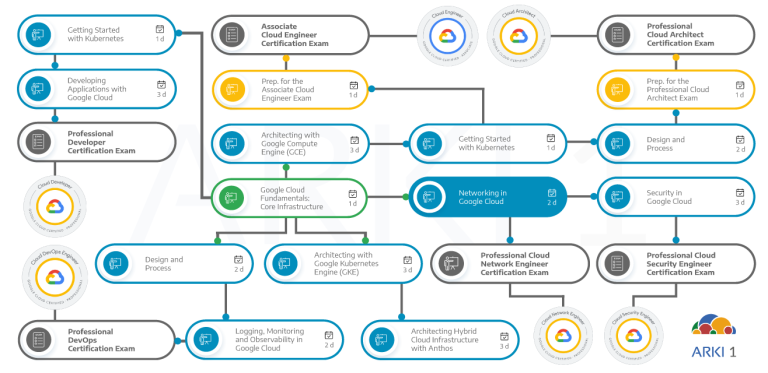This 2-day instructor-led course offers participants a comprehensive study of network options on the Google Cloud platform. Through a combination of presentations, demonstrations, and hands-on labs, participants explore and implement GCP network technologies, such as:
- Google Virtual Private Cloud (VPC) networks, subnets, firewalls; interconnection between networks; load balancing;
- DNS in the cloud;
- Cloud CDN;
- NAT from the cloud.
Objectives
Este curso enseña a los participantes las siguientes habilidades:
- Utilizar las mejores prácticas para el desarrollo de aplicaciones.
- Elegir la opción de almacenamiento de datos adecuada para los datos de su aplicación.
- Implementar la gestión de identidad federada.
- Desarrollar componentes de aplicación o microservicios ligeramente acoplados.
- Integrar componentes de aplicaciones y fuentes de datos.
- Depurar, rastrear y monitorear aplicaciones.
- Realizar implementaciones repetibles con contenedores y servicios de implementación.
- Elegir el entorno de ejecución de la aplicación apropiado.
- Usar Google Kubernetes Engine como un entorno de ejecución y luego cambie a una solución de entorno independiente con Google App Engine Flex.
Audience
This class is intended for network engineers and network administrators who use or plan to use the Google Cloud Platform. The class is also for people who want to expose themselves to software-defined network solutions in the cloud
Prerrequisites
To fully benefit from this course, participants must comply with the following criteria:
- Have completed Google Cloud Fundamentals: Core Infrastructure or have equivalent experience.
Duration
16 hours (2 days)
Inversión
Check the next open public class in our enrollment page.
If you are interested in a private training class for your company, contact us.
Course Outline
The course includes presentations, demonstrations, and hands-on labs.
- Recall that networks belong to projects
- Explain the differences among default, auto, and custom networks
- Create networks and subnets
- Explain how IPv4 addresses are assigned to Compute Engine instances
- Publish domain names using Cloud DNS
- Create Compute Engine instances with IP aliases
- Create Compute Engine instances with multiple virtual network interfaces
- Outline how IAM policies affect VPC networks
- Control access to network resources using service accounts
- Control access to Compute
- Engine instances with tag-based firewall rules
- Outline the overall workflow for configuring shared VPC
- Differentiate between the IAM roles that allow network resources to be managed
- Configure peering between unrelated VPC networks
- Recall when to use shared VPC and when to use VPC peering
- Recall the various load balancing services
- Configure Layer 7 HTTP(S) load balancing
- Whitelist and blacklist IP traffic with Cloud Armor
- Cache content with Cloud CDN
- Configure internal load balancing
- Determine which GCP load balancer to use when
- Recall the GCP interconnect and peering services available to connect your infrastructure to GCP
- Explain Dedicated Interconnect and Partner Interconnect
- Describe the workflow for configuring a Dedicated Interconnect
- Build a connection over a VPN with Cloud Router
- Determine which GCP interconnect service to use when
Explain Direct Peering and Partner Peering - Determine which GCP peering service to use when
- Recognize how networking features are charged for
- Use Network Service Tiers to optimize spend
- Determine which Network Service Tier to use when
- Recall that labels can be used to understand networking spend
- Explain common network design patterns
- Automate the deployment of networks using Deployment Manager
- Launch networking solutions using Cloud Marketplace
- Configure uptime checks, alerting policies, and charts for your network services
- Use VPC Flow Logs to log and analyze network traffic behavior


